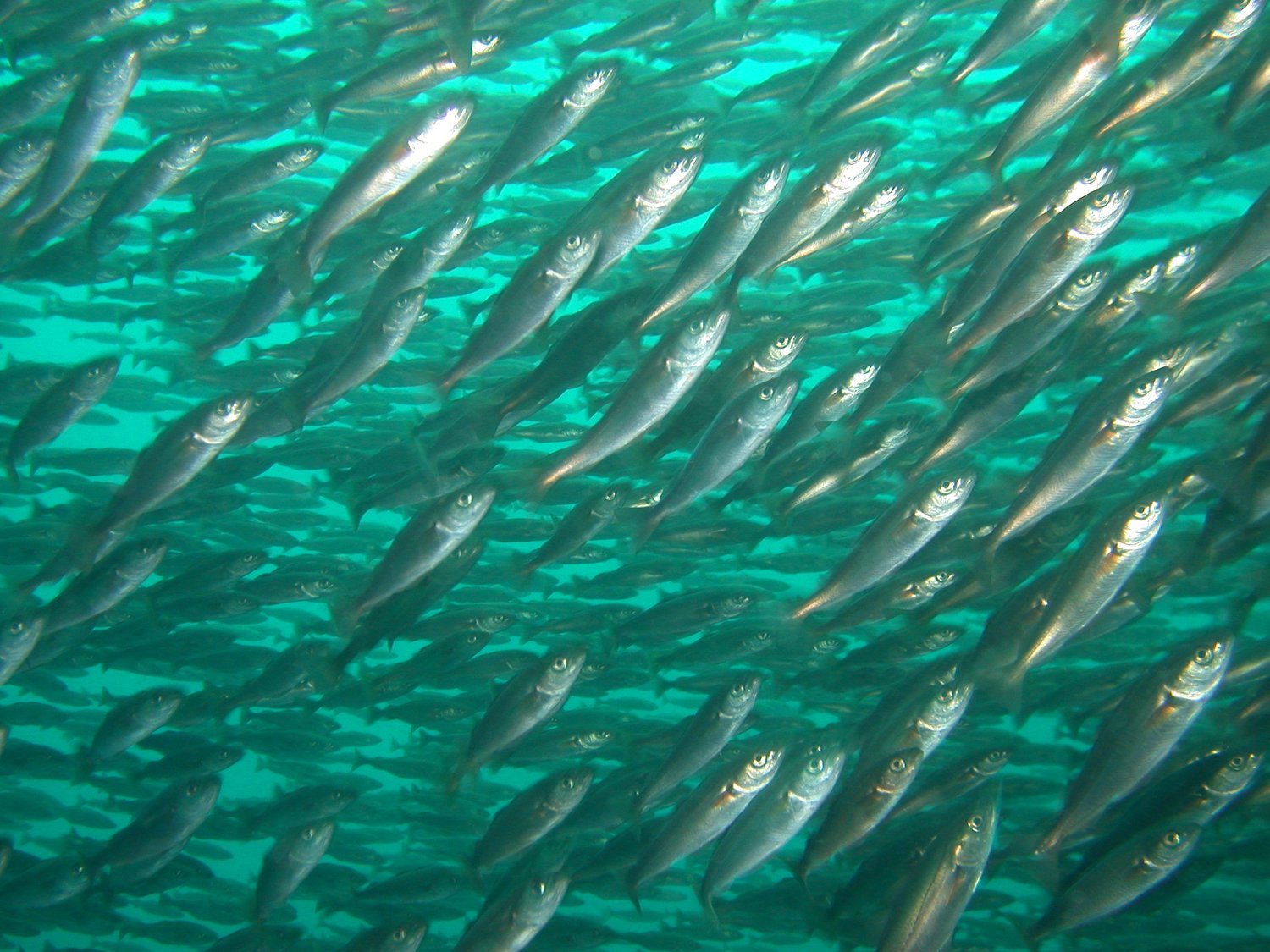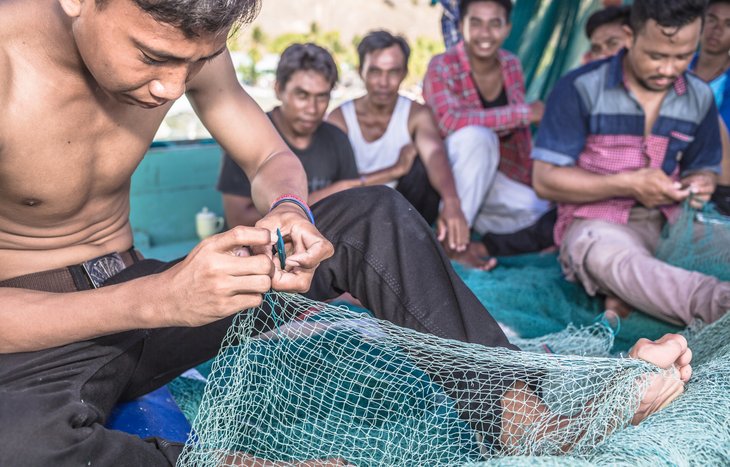Fish and seafood are among the most traded food products in the world. Around 3.3 billion people now meet part of their protein intake by eating fish.
Increasingly, the fish on our plates comes from aquaculture. However, according to official figures, 79.7 million tonnes of fish were still caught in the oceans in 2022(1). Including the many illegal catches and discarded bycatch, the total catch amounts to more than 100 million tonnes of fish per year.
Fish is a lifeline for millions of people, providing both food and income. While many small and medium-sized fishing businesses in industrialised nations have had to cease operations, fishing remains an important source of income for local populations in many developing and emerging countries. According to estimates by the Food and Agriculture Organization of the United Nations (FAO), up to 820 million people are directly or indirectly dependent on fishing. It is estimated that there are around 54 million fishers worldwide (87 per cent of them in Asia), while the remainder includes the families of fishers, suppliers, and their families(2).
Fishing is not all the same
There are many different forms of fishing. The majority of fish come from industrial fishing. This is carried out using ships that are usually between 18 and 40 metres long and can spend days at the ocean. After their voyage, they land their catch in a large port. For large-scale deep-sea fishing, vessels of up to 80 metres in length (such as so-called super trawlers) are used. These ships remain at sea for weeks, and the crew processes the catch directly on board.
In addition to industrial fishing, there is also small-scale coastal fishing. These small-scale fishers typically go out for just a day, using a cutter (or, in some non-European countries, wooden boats without a wheelhouse) and fish in coastal waters. Between these broadly defined types of fishing, there are numerous gradations in terms of operation and vessel size(2).
Marine fish stocks
Within just a few decades, industrial fishing has expanded from traditional fishing grounds in the Northern Hemisphere to cover all the world’s oceans. Many populations of commercially valuable fish are considered overfished. However, the situation is not hopeless. Various countries have already demonstrated that fish stocks can recover through sustainable fisheries management. At the GEOMAR research centre, scientists are exploring solutions for environmentally friendly fisheries management.
Further information: www.geomar.de/en/discover/fisheries-research
Illegal fishing also poses a serious threat to the preservation of fish stocks. It occurs when vessels violate fisheries laws, for example, by fishing without permission in a country’s territorial waters or by disregarding protected areas and fishing seasons. Unreported fishing is another issue - when only part of the actual catch is declared to the authorities. Compliance with fisheries laws is monitored by a combination of national, regional, and international actors and mechanisms. Though, these measures are only as effective as their enforcement. Challenges such as insufficient resources, corruption, and a lack of cooperation make monitoring fishing activities worldwide more difficult(3).

Which fish are still a sustainable choice?
In Northern Europe alone, around 200 fish stocks are commercially exploited, but only a few of them meet the internationally binding criteria for sustainable fishing. The GEOMAR research centre has partnered with German consumer organisations and several NGOs to publish an annual list of marine fish that currently represent the best alternative for those who do not wish to give up eating fish.
For the “Good Fish” list, researchers at GEOMAR carry out the scientific assessment of sustainable stock size and sustainable fishing pressure, ensuring compliance with these criteria. Their evaluation is based on the United Nations Convention on the Law of the Sea and its implementation in the EU's Common Fisheries Policy. According to these regulations, fish stocks must be larger than a minimum threshold that allows for the highest possible long-term yield. Additionally, fishing pressure on a stock must not exceed the level that ensures the maximum sustainable yield in the long run. Other criteria, such as gentle fishing methods with minimal bycatch, are assessed by the project’s partner organisations.
Fish stocks online
The ‘Fish Stocks Online’ portal provides comprehensive, up-to-date and scientifically verifiable information on the status of wild marine fish stocks that are important for the German market. The information is organised according to individual fish stocks, which can develop in completely different ways. In addition, all other aspects relevant to the assessment of ecologically sustainable fisheries are described. The website is maintained by the Thünen Institute, the German federal institute responsible for the assessment of commercially utilised fish stocks.
Fish from aquaculture
Marine fish are also bred in aquaculture, along with mussels, crustaceans, algae, and other marine organisms. In 2022, global production of marine and coastal aquaculture reached a total of 71.1 million tonnes, including 35.3 million tonnes of aquatic animals (65.2% fish, 20% molluscs, 13.5% shellfish, and 1.3% other animals), as well as 36.4 million tonnes of algae.
Aquaculture plays a crucial role in meeting the growing global demand for seafood and provides a protein source for billions of people. It can reduce pressure on wild fisheries and contribute to the preservation of marine ecosystems. However, wastewater and chemicals used in aquaculture can impact the environment and ecosystems, and diseases and parasites pose risks to animal health. In coastal areas, aquaculture can lead to conflicts over land use; in particular, the farming of tropical shrimp can result in the destruction of natural coastal ecosystems.

In light of these challenges, fisheries experts are working on concepts for sustainable fishing and aquaculture. A key focus is combating illegal fishing, where the combination of ship and satellite data has now led to significant successes. In fisheries management, experts are relying on ecosystem-based solutions that incorporate knowledge about the state of local fish stocks, as well as the needs of fishers and coastal populations, into planning. Furthermore, all stakeholders are to be involved in decision-making processes.
In aquaculture, the goal is to minimise the harmful environmental impacts of intensive farming. To this end, closed-loop systems are being developed, plant-based feed options are being tested for suitability, and integrated systems that combine fish, plants, and filter feeders in one facility are being designed, allowing nutrients to be directly reused. However, it will take time for these concepts to become widely adopted in the production of fish and seafood. Nonetheless, the major global crises cannot be effectively addressed without sustainable fisheries management and environmentally friendly production in aquaculture.
- Food and Agriculture Organization of the United Nations (FAO), 2024: "The State of World Fisheries and Aquaculture 2024 – Blue Transformation in action", Rome. https://doi.org/10.4060/cd0683en
- World Ocean Review 2, "Die Zukunft der Fische - die Fischerei der Zukunft" (2013), Kapitel 2 “Von Fischen und Menschen”
- FAO: https://www.fao.org/iuu-fishing/en/



![[Translate to English:] Fischer sortieren Königskrabben an Bord eines Kutters](/fileadmin/_processed_/d/2/csm_OceanImageBank_JeffHester_08_58f4baec15.jpg)




